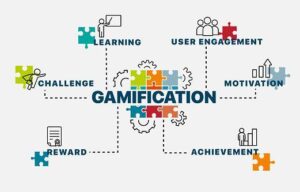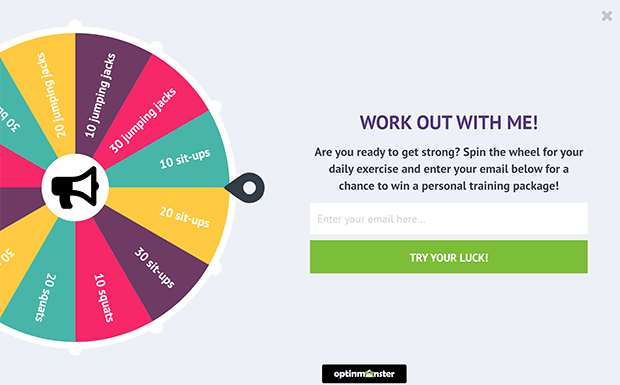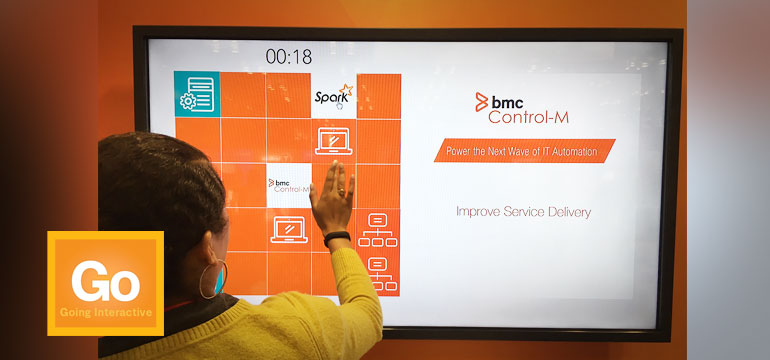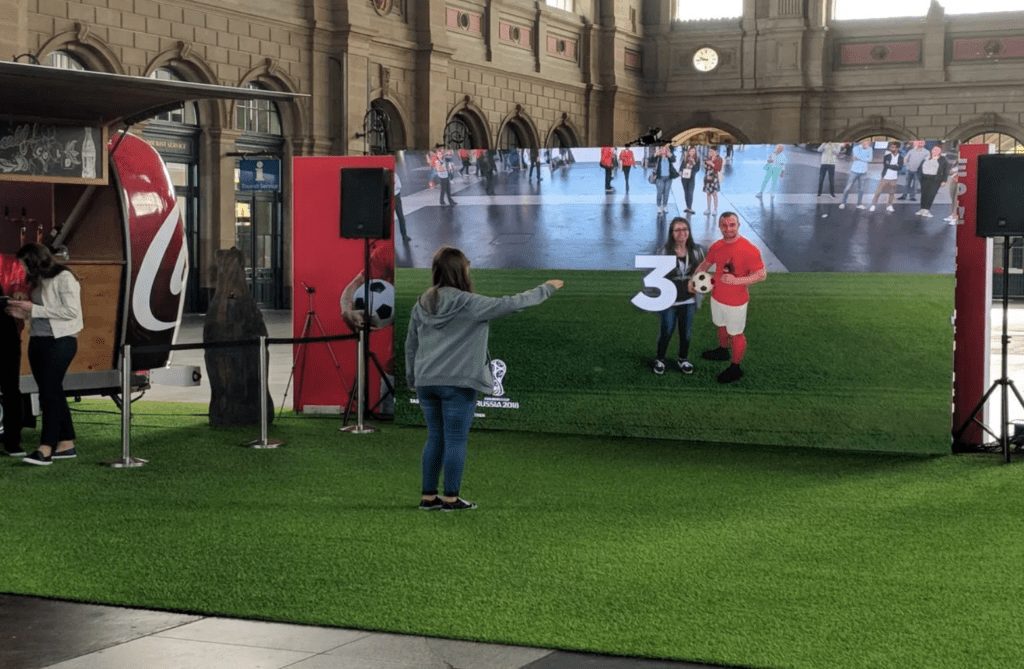Gamification in the Exhibition Space: All your Whys and Hows of Maximizing Audience Engagement Answered

Outline
- Introduction
- What is gamification marketing? Benefits of gamification in marketing
- Types of Interactive Displays
- Event gamification strategies to reap maximum returns
- Gamification for trade shows and exhibitions
- Examples of exhibition and trade show gamification to boost audience engagement
- Conclusion
1. Introduction
By now, we are all surely aware of the perils all work and no play entail for poor Jack. From workspaces to stacking up daily essentials in the cart, a little bit of fun is not only desirable but also mandatory to engage our multiple senses and combat the giant wall that businesses and campaigns face in the form of decreasing attention spans of the modern man.
The grand year of 2022 had the entire world caught in a Wordle frenzy. This daily free mental exercise was such a prominent global phenomenon that it helped boost subscription rates of the New York Times and also led to the creation of various paid and unpaid spin-offs of the game. Daily streaks and the ability to share stats on social media efficaciously cemented Wordle into the routine of many a users, such is the power of simple gamification.
Gamification refers to the practice of incorporating one or more game elements and mechanics into non-game contexts to engage, motivate, and influence behavior. It involves applying game design principles, such as competition, rewards, achievements, and challenges, to activities and experiences that typically do not involve games, ranging from education and training to conferences and exhibitions.
The purpose of gamification in the exhibition space is to make tasks or interactions more enjoyable, increase average engagement time, and drive desired behaviours sans cold pitching. Why is it effective? Well, gamifying an experience taps into the psychological aspects of games that captivate and spur players on, give a sense of accomplishment and progress and thus encourage social interaction and provide intrinsic motivation. It’s important to note that gamification is not necessarily about turning everything into a game, but rather using game elements such as challenges and rewards strategically and purposefully to enhance the desired experience and outcomes.
2. What is gamification marketing?
Gamification marketing involves integrating gaming elements into consumer activities and interfaces to enhance engagement and motivate users to perform specific actions. In marketing, gamification utilizes common game elements like scoring points, leveling up, or earning virtual currency to amplify user engagement and drive conversions. The audience, whether customers, leads, fans, followers, or readers, engages in a game that offers the opportunity to win something, while the marketing team benefits from an enhanced marketing impact.
Using gamification techniques in marketing strategies can effectively stimulate user engagement and dwelling time and foster customer loyalty. A gamification campaign can serve as a potent tool for gaining industry insights and collecting data from both existing and new users. By employing psychological mechanisms such as point systems, friendly competition, and challenges within an interactive experience that incorporates adequate branding and product placement, businesses can yield improved conversion rates and cultivate a base of loyal customers.
3. Benefits of gamification in marketing
Gamification marketing has been here for decades, if not longer. But it is only in the recent years that businesses worldwide, big or small, have truly caught up with the trend and capitalized on the availability of social media platforms, digital workspaces and the easier access to technologies such as augmented reality and virtual reality to gamify experiences. Gamifying a marketing campaign bestows the following benefits:
-
Greater involvement of participants:
With a game as one of your booth highlights, you are bound to see proactive interest from attendees. Not only will they volunteer to sign up and play but also increase repeated visits to check scores and collect prizes. -
Greater involvement of participants:
Cultivate brand loyalty: An efficient rewarding system, along with branded games that build a community among your audience, ensure that customers come back to you. -
Create diverse user-generated content:
Winning at games comes with bragging rights on social media. Additionally, participants would want to share their unique experience at your booth, playing your branded game or taking a virtual tour. Thus, gamification stimulates UGC, encourgaes more people to use campaign-specific hashtags, increases digital traction and word-of-mouth marketing. -
From awareness to edutainment:
Branded marketing games, trivia and polls create brand awareness in a fun way, act as an ice breaker and incorporate a learning-by-doing, proactive method of acquiring information and making value judgements. -
Lead generation:
Be it classic lead generation games such as the Wheel of Fortune or gamified activities like the Digital Slingshot to generate content, you are sure to get better results with event gamification. -
Boost conversion rates:
Accumulated rewards and coupons through gamification tactics decrease bounce rates and keep visitors coming back for more rather than simply discarding your message as yet another among a hundred ordinary ones they are routinely prompted with. -
Employ multiple platforms:
Say goodbye to traditional marketing and engage the various means at your disposal. Turn digital traction into actual footfall by running an online contest with benefits to be reaped at the event, motivate social shares and official hashtag usage, increase mobile app downloads to enable your brand to become a part of the users’ daily lives. -
Affordability:
Gamification techniques can be moulded easily as per your budget. You may go all out with digital setups or choose an MC to lead an interactive game or live trivia.
4. Event gamification strategies to reap maximum returns
Trade shows are competitive events where exhibitors vie for the attention of potential customers and partners. One way to stand out and create a memorable impression is to use gamification, as it can increase engagement, loyalty, and awareness by tapping into people’s intrinsic motivations, such as curiosity, challenge, feedback, and reward. To put it succinctly, you may choose ethier of the two routes to gamify your event- opt for a game that has been custom-made and preferably branded for edutainment, OR incorporate features of game design into the activities and overall event experience.
Here is a comprehensive list of pointers when attempting event gamification:
Keep it simple:
The game rules and technology should be easy enough to be understood by a wide demographic without requiring a verbose instruction manual.
Provide incentives smartly:
Prizes shouldn’t necessarily or only be awarded to winners and top scorers. Show your audience that it’s all about having fun and strike a balance between skill and chance.
Stir a competitive spirit, albeit moderately:
Competition isn’t key to gamification, motivation is. Allow for team player setups so that friends may enjoy the experience together and make happy memories at your booth.
Create a novel experience:
Smart branding, merchandising and customisation can turn the most ordinary gamification tactic into an amazing impression that will endure in the hearts of participants.
Go the time-tested way:
Nostalgia is a powerful ingredient in gamification. Think MarioBros., Whac-a-Mole and other immensely popular arcade games which can be converted into digital look-alikes for your audience.
Enable social sharing:
Prompt your players to share their gaming experience on social media. You may even attach some perks or display their posts on a Social Wall for a pat on the back.
Set up a live leaderboard:
Ensure that your gamified booth garners attention as well as repeat visits to keep track of scores with a prominent leaderboard placement.
5. Gamification for trade shows and exhibitions
At any exhibition or trade show, there are different types of visitors. You’ve got wanderers who simply drift from one spot to another, often in search of freebies or something particularly exciting. Then there are the surveyors who may simply be window-shopping as part of the general crowd or collecting details with a keen interest in the concerned field. Lastly, there are the spenders with varying degrees of purchasing power. Now, amidst all the rush that such events usually entail, it is certainly no easy task to identify which of the aforementioned type is headed your way so that you may brace yourself with a pitch accordingly. Turns out, gamification for exhibitions is a great way to bypass the awkwardness of these interactions and convert passive bystanders into active leads.6. Examples of exhibition and trade show gamification to boost audience engagement
Gamifying a marketing campaign is often easier than it sounds. What is important that you list your agenda and accordingly opt for a gamification track that will highlight your brand’s accessibility and creative, user-friendly approach. Following are the fundamental routes to trade show gamification that will generate the required buzz and turn heads towards your exhibition stand.-
Trivia Games and Polls:
Perhaps one of the most economical ways to instill brand awareness among the audience is to host a live trivia that allows top scorers to win a prize or obtain digital collateral that they may encash in other ways against your products and services. You may also set up an interactive display with informative polls for the same purpose. Depending on whether your audience comprises experts and aficionados of a particular industry, as when you might be participating in a conference, or a general, more varied crowd, you can set up quiz questions and difficulty levels. Better still, keep the options open and allow the players to themselves select the tiers based on their confidence.

Wheel of Fortune/Scratch and Win:
Perhaps the most commonly sighted of trade show games, a chance-based setup such as Spin the Wheel or a Lucky Draw certainly draw in massive crowds. You may distribute raffle and coupons on social media as part of pre-marketing, generating hype for the event. Acting as efficient lead generation games, these tangible reward-based tactics open endless doors for creativity and customization. You can opt for digital check-in that doubles as a raffle entry.
Digital Games:
The digital revolution is upon us, and almost every arcade game that you could recall from your childhood or your favourite 90s film can be simulated by technology. From sorting games and memory games to conga lines and escape rooms, the options are endless.

Multi-platform Contests:
Gamification also bestows benefits on pre-event marketing. You may employ social media to run an online contest with winners to be announced at the event and increase buzz and actual footfall. Running event-specific hashtags with associated perks also amplifies digital interaction, which you may further harness by setting up a Hashtag Printer booth or a Digital Slingshot.
AR and VR-enabled Experiences:
These immersive, highly interactive technologies are a sureshot way to wow your audience. Augmented Reality and Virtual Reality are increasingly being utilised not just in the form of console games but also to enhance the overall exhibition experience by making it highly interactive, prompting information at will, offering virtual tours and trials, etc.
Scavenger Hunt:
An excellent way to functionally expand your brand’s presence beyond your booth, a treasure hunt is an excellent way to send participants on a chase and keep them coming back for more. Use hashtags and QR codes to hide clues and split the hunt into several stages with relative rewards.
Conclusion
Gamification in the exhibition space, done right, is a powerful way to secure a foothold among a wider and more varied audience. It speaks of your understanding of your targeted consumer groups and your willingness to not simply ride the trends but understand and master them. Gamification marketing for trade shows and exhibitions isn’t simply about numbers, stats and ROI figures but about curating an experience for attendees that leaves an indelible impression regarding your brand and work ethic.



